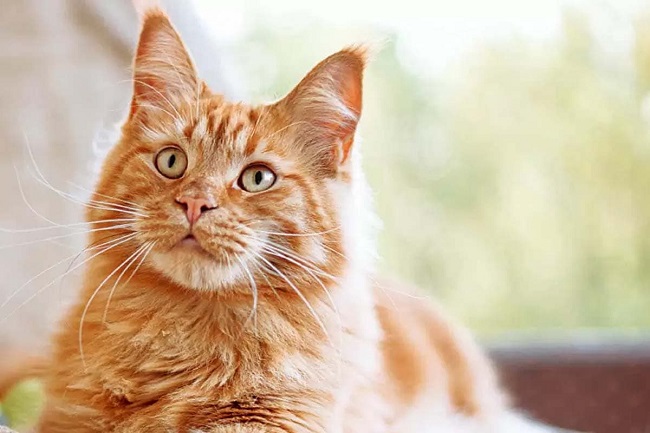Orange cats are beloved for their warm and vibrant fur, which adds a touch of sunshine to our lives. In this article, we will delve into the world of orange cat breeds, exploring the different breeds that sport this striking coloration.
From the well-known ginger cats to the lesser-known breeds, we will provide detailed information about each breed’s characteristics and what makes them unique.

Orange Cat Breeds
Here are some of the orange cat breeds:
Read Also:
Tabby Cats
Tabby cats are a common and diverse group that includes various coat patterns, one of which is the orange tabby.
These cats have a distinctive mottled pattern with stripes or spots on their fur. Orange tabbies are known for their friendly and affectionate nature, making them popular pets in households worldwide.
Maine Coon
Maine Coon cats, one of the largest domestic cat breeds, can also be found in orange variations. They have a luxurious and dense coat that comes in various colors, including orange.
Maine Coons are known for their gentle and sociable disposition, making them excellent companions.
Scottish Fold
Scottish Fold cats are famous for their unique folded ears, and they can also exhibit an orange coat. These cats have a sweet and gentle personality, often forming strong bonds with their owners.
The combination of their distinctive folded ears and vibrant orange fur makes them a striking breed.
Abyssinian
While Abyssinians are typically associated with their warm reddish-brown coat, they can also display shades of orange. These cats have a sleek and muscular build, with a coat that has a ticked or agouti pattern.
Abyssinians are highly active and intelligent cats, always ready for adventure and play.
Persian
Persian cats, known for their long and luxurious coats, can also be found in beautiful shades of orange. With their sweet and gentle temperament, Persian cats make delightful companions. Their abundant fur and striking coloration add to their regal and majestic appearance.
Egyptian Mau
The Egyptian Mau, an ancient and elegant breed, can occasionally exhibit an orange coat. These cats have a spotted pattern reminiscent of their wild ancestors.
Egyptian Maus are intelligent, agile, and highly affectionate, forming strong bonds with their human companions.
Bengal
Bengal cats are known for their striking coat patterns, which often include a mix of orange and brown rosettes or marbled patterns.
They have a wild appearance, resembling their ancestral leopard cats. Bengal cats are highly active and require mental and physical stimulation.
Health Considerations for Orange Cats
These are some of the health consideration of orange cat breeds:
Dental Care
Just like any other cat, proper dental care is crucial for orange cats. Regular brushing of their teeth helps prevent dental issues such as tartar buildup and gum disease.
Providing dental treats or incorporating dental health supplements into their diet can also contribute to maintaining good oral hygiene.
Nutritional Needs
Meeting the nutritional needs of orange cats is essential for their overall health and well-being. High-quality cat food that is appropriate for their age and specific dietary requirements is recommended.
Consult with your veterinarian to ensure that your orange cat receives a balanced diet that supports their unique nutritional needs.
Sun Sensitivity
Orange cats, especially those with lighter-colored coats, may be more susceptible to sun sensitivity. Their lighter fur and skin make them prone to sunburn and increased risk of skin cancer.
Limiting their exposure to direct sunlight, providing shaded areas, and using pet-safe sunscreen on sensitive areas like the ears and nose can help protect them from harmful UV rays.
Routine Veterinary Care
Regular veterinary check-ups are vital for maintaining the health of orange cats. Schedule routine wellness exams to monitor their overall health, address any concerns, and receive necessary vaccinations.
Preventive care, such as flea and tick prevention and regular deworming, should also be part of their healthcare regimen.
Exercise and Mental Stimulation
Orange cats, like any other feline, require regular exercise and mental stimulation to prevent boredom and maintain a healthy weight.
Engage them in interactive play sessions with toys, provide scratching posts, and create opportunities for climbing and exploring. Enrichment activities help keep their minds and bodies active.
Obesity Prevention
Obesity is a common health concern among cats, including orange cats. Maintain a balanced diet and portion control to prevent excessive weight gain.
Encourage physical activity through play and provide opportunities for exercise. If necessary, consult with your veterinarian for guidance on weight management and appropriate feeding practices.
Vaccinations and Preventive Care
Orange cats, like all cats, should receive essential vaccinations to protect against common infectious diseases. Vaccination schedules should be followed according to your veterinarian’s recommendations.
Additionally, regular flea and tick prevention, as well as routine deworming, are crucial to safeguard your orange cat’s health.
Environmental Safety
Creating a safe environment is essential for the well-being of orange cats. Ensure that your home is free of hazards such as toxic plants, chemicals, or small objects that could be ingested. Keep electrical cords out of reach and secure windows and balconies to prevent accidental falls.
Read Also:
Conclusion
Orange cat breeds encompass a diverse array of feline companions, each with its own unique characteristics and charm. Whether it’s the playful and affectionate Tabby, the regal Persian, or the exotic Bengal, these cats bring warmth, joy, and companionship to our lives.
When considering an orange cat breed as a pet, it’s important to research each breed’s specific needs and traits to ensure a good match for your lifestyle. These captivating cats with their vibrant coats will undoubtedly bring love and happiness to any cat lover’s home.
























